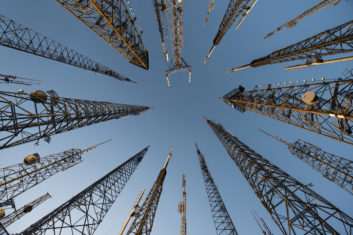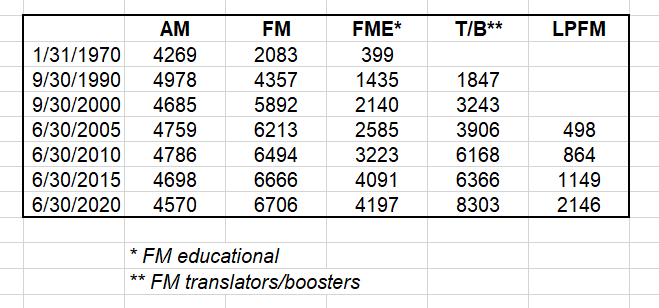
Text has been updated with total number of translators held by AM stations.
I always look forward to the latest FCC totals of licensed U.S. radio stations; I guess I’m a radio geek. (I don’t run down the street yelling “The new license data are here,” at least not yet.) But whenever the latest numbers come, I like to dive back into the historical record to see how they’ve changed over time.
The fresh report from the Federal Communications Commission reveals that as of June 30, there were 4,570 licensed AM stations, 6,706 commercial FMs and 4,197 educational FMs, for a total of 15,473 full-power U.S. radio stations.
But of course the FM band is much more crowded than that because there are also 2,146 low-power FMs and 8,303 translators and boosters.
So how does that compare to the past?
For kicks I took historical FCC data from several points over several decades and put them into a table below. I thought you’d be interested in this. Note that the first two rows are from 1970 and 1990; and then starting in 2000 I took five-year increments. Totally arbitrary on my part … I could for instance have used 1996 as a year of particular note in radio regulation. Maybe next time.

Among the trends you can spot here are the growth and then dips in the AM numbers; the boom of the FM band of the late 20th century; the near-doubling in the number of NCE FMs over the past two decades; the launch and then growth of low-power FMs (though observers sometimes wonder how many of these licensees are active); and the explosion in the translator/booster category, up 30% just in five years (helped, though not solely driven by, the AM revitalization program).
And those who believe that the U.S. has an FM congestion problem will no doubt find it interesting that in 1990 the United States had 7,639 FM licensed signals (a number reached by adding 1990’s totals for FM commercial, FM NCE and translators/boosters). But in 2020, thanks to significant growth of all three categories plus the addition of LPFMs, there are 21,352 licensed signals on the FM band. Wow.
(An additional point of interest: An FCC official told me after this article was first published that, out of 4,567 AM stations, 3,131 have FM translators licensed or authorized for construction. So this means that there are just the number of FM translators held by AM licensees now exceeds the total number of FM stations of 1970.)
All of the above is just raw data and doesn’t reflect, for instance, the impact on the FM band of the almost infinite variety in coverage footprint, power levels and so forth. But maybe the current debates over synchronized boosters for geo-targeting and whether to allow translators to originate content will cause those numbers to spike further. Check back with me in 10 or 20 years.
[Related: “GBS Gathers Support for Geo-Targeting”]
[Related: “Should Translators Originate Content? FCC Is Taking Comments”]












